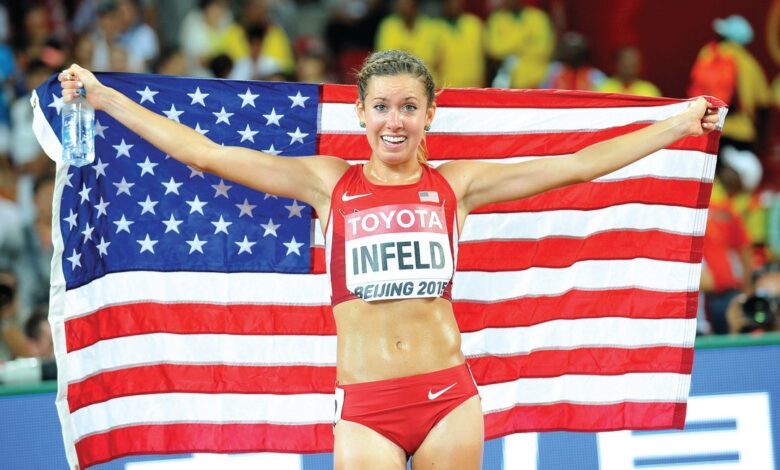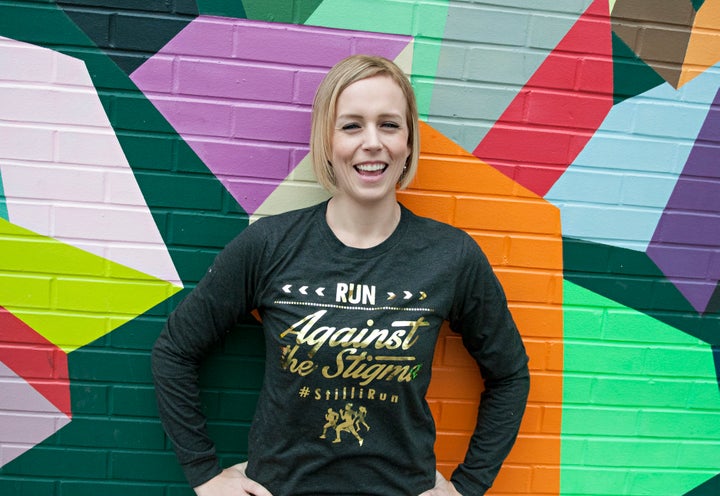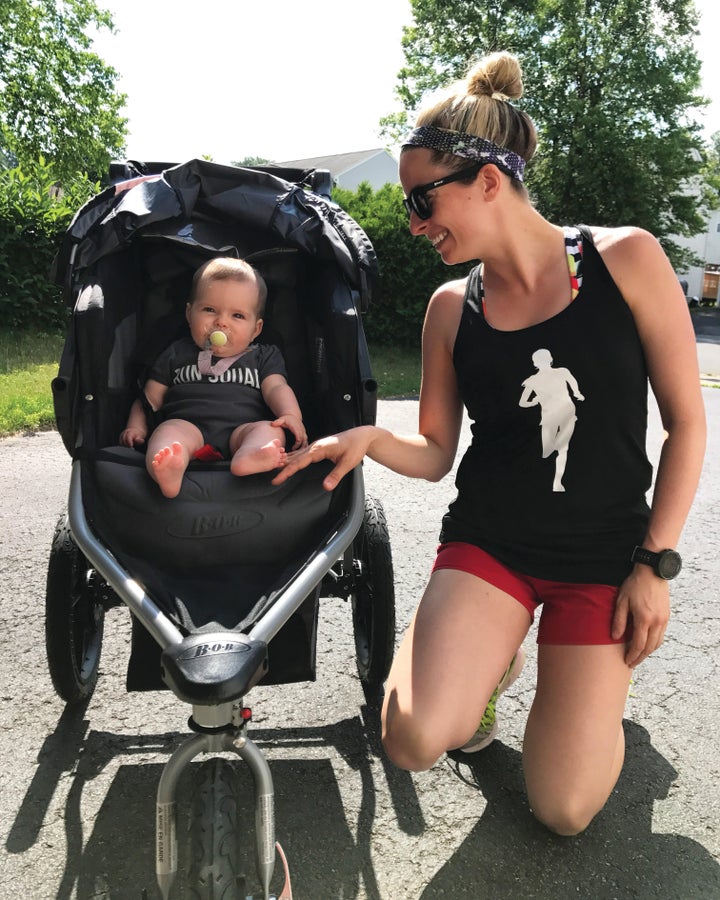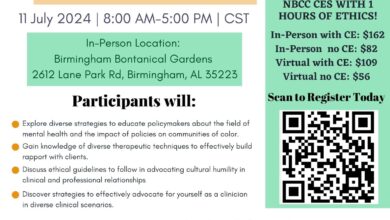5 Courageous Women Who Are Running Down Mental Health Stigmas

“], “filter”: { “nextExceptions”: “img, blockquote, div”, “nextContainsExceptions”: “img, blockquote, a.btn, a.o-button”} }”>
New perk! Get after it with local recommendations just for you. Discover nearby events, routes out your door, and hidden gems when you
>”,”name”:”in-content-cta”,”type”:”link”}}”>sign up for the Local Running Drop.
Emily Infeld has always been the picture of happiness. Her social media is filled with positivity, heart emojis, and giggles. But in 2018, during Mental Health Awareness week, she was inspired to reveal a hard truth that few people knew about her: The 2016 Olympian in the 10,000 meters has struggled with anxiety for most of her life.
“It’s something that’s so personal, and you never know how people are going to take it,” Infeld says. “I also didn’t want anybody to feel sorry for me. That’s not what it’s about—it’s bringing awareness to the struggles people have so that you can help others know that it’s okay.”
Growing up, Infeld, 29, was convinced that because she was an athlete—driven, competitive and focused—it naturally produced feelings of anxiety. And to a certain extent, nervousness could help fuel her performance. But when does a healthy dose of fear tip more toward a debilitating helping of anxiety?
It wasn’t until she graduated from Georgetown University and went on to a professional running career with the Bowerman Track Club in Portland, Oregon, that Infeld started noticing symptoms of depression, spurred in 2013 by her first major injury, a stress fracture in her sacrum.
“I was just in a dark, dark place that I couldn’t really get out of,” Infeld says. “I love life, I love laughing, I have so much support, so many friends, and when you’re surrounded by all that support and all those wonderful things, but you can’t get yourself out of that hole—I beat myself even more so. Why am I feeling so sorry for myself? There’s something wrong with me.”
It was at that point that Infeld sought help from a sport psychologist and a psychiatrist for treatment, which has also educated her about the many degrees and forms of psychological distress and how many people suffer in silence. The Centers for Disease Control estimate that one in every six adults in the United States will experience depression at some time in their lives.
“I had a friend who committed suicide in college, which was heartbreaking and really hard. I’ve never been in that place, which I’m thankful for,” Infeld says. “A big part of that is it was somebody who felt like they couldn’t share how they were feeling. When you feel so alone and like nobody understands what you’re going through, it’s terrible. That’s why I felt inclined to share my struggles.”
Suicide is the 10th leading cause of death in the U.S., according to the CDC. Running is a means to managing mental health disorders—research shows that consistent physical activity can help relieve symptoms of depression—and also a platform to discuss such issues openly, reach more people who may need support and encourage them to seek what can sometimes become life-saving treatment.
Along with Infeld, here are four women runners who are helping to lead the charge in mental health awareness.
Seeking support systems: Renée Tomlin

Pro triathlete Renée Tomlin speaks out about the importance of mental health in performance.
Infeld and Renée Tomlin, now a pro triathlete, were teammates on the track and cross-country teams at Georgetown, but their bond has grown tighter and stronger as they’ve entered the rollercoaster of post-collegiate competition. The duo has discovered no matter what kind of profession you’re in, success is highly dependent on making sure you’re part of a team that is with you during the highs and the lows.
For Tomlin, 30, it was a hard lesson learned during injury. She ended up joining a pro triathlon training group in Spain—one that she describes as intense. It wasn’t long after arriving there that she was sidelined with a navicular stress fracture. She returned to her home in New Jersey for treatment, but she then jumped back into training too quickly and reinjured herself.
“I was diagnosed with my injury when Emily was going through her third or fourth bout of injury. Through this whole process, we would check in with each other, support one another,” Tomlin says. “I’ve come to realize how important mental health is and how much of a foundational factor it is for physical health. It’s just as important, if not more.”
Injuries can cause situational depression or exacerbate existing mental health conditions. Tomlin discovered that when she was hurt, she didn’t have the proper coping mechanisms at the ready, which was a blow to her recovery.
“I had to come to terms with the fact that my environment was not healthy for me mentally, emotionally, or physically,” she says. “I stripped it down to people I know I can trust, have my best interest and want to maximize my health, and will communicate with me. It was a reevaluation of that.”
Part of Tomlin’s new team was a sport psychologist. During the second round of injury, she recognized she had symptoms of depression.
“Saying things out loud to somebody who wasn’t my mom or my significant other—it was a way for me to get feedback that it was okay that I was feeling the way I was,” she says. “It was an awareness and an intention. My conversations are a spectrum from getting through an intense emotional experience to focusing on race prep.”
Tomlin has found strength in hearing other people’s stories, too, which is why she feels it’s important to now tell her own.
“It normalizes the experience and makes it less taboo,” she says. “Why wouldn’t you want to share that secret? It humanizes everybody. Achievement is gritty and dirty and messy and sad and scary. You don’t always see those pieces.”
Documenting disease: Emma Kertesz

Emma Kertesz documents her struggles with mental health hoping her platform in running might help others.
Emma Kertesz, a 26-year-old Olympic Trials qualifier in the marathon, always considered herself emotional. In high school, she’d feel the highest of highs, then bottom out to the lowest of lows. She assumed everybody felt the extremes the same way she did.
“I didn’t really do much about it. I assumed that’s what it was to be a person growing up, in high school and college,” she says. “But when it got really bad after college, working with my doctor and a psychiatrist, I got a bipolar diagnosis.”
Bipolar causes unusual swings in mood, energy and activity levels, which affects the ability to carry out day-to-day tasks, according to the National Institute of Mental Health. For Kertesz, who is also a pre-kindergarten teacher in Boulder, Colorado, the diagnosis was difficult to hear, though it also brought relief to know there was a reason she felt the way she did. Before that visit to the doctor in 2014, Kertesz was suicidal, she says.
Three years later, Kertesz realized she was going through another severe episode related to her bipolar disorder. She began hallucinating, hearing chatter in her house when she knew nobody was there, or seeing shadows and light that didn’t exist, and thought that the only way to make it stop was to kill herself.
“I thought that because I was on medication, I was seeing a therapist and I was a pretty functioning person in society, if this was still happening to me, there’s no way to fix it,” Kertesz says. “In that moment, it was so bad I thought it was the only way.”
She went to a walk-in mental health clinic, where it was concluded quickly that she needed to be hospitalized. There, she engaged in group therapy and waited for a doctor to see her. Kertesz felt defeated and “deeply sad that I had ended up there.”
The experience, however, was eye-opening and led to a new protocol with her therapist. One new tool she began utilizing is a number system. The people in her inner circle can ask her anytime, “What’s your number?” and she rates herself on a scale of 1–10 (one is severely depressed and 10 is so manic she’s capable of making life-altering decisions).
“I realized that I really need to take care of myself. I had let how I was feeling go on too long,” she says. “Had I told somebody how I was feeling, I probably could have remedied the situation in a less severe manner.”
In February 2018, Kertesz decided to talk about her darkest episode publicly, posting photos of herself in the hospital and explaining her disease.
“It was important for me to share as a person in the running community to show people that it’s okay to work on yourself,” she says. “There’s so much pressure on people to be the final product, instead of showing the process and what they’re going through. Instagram is a nice, curated gallery of people’s successful moments. I wanted to show that there are real-life issues going on that aren’t so pretty, and it’s okay to talk about them.”
Since then, the reaction has been overwhelming—and full of gratitude.
“People came out of the woodwork saying that they felt like nobody talks about this,” Kertesz says. “It’s okay to ask for help. That message is incredibly important.”
Bringing people together: Sasha Wolff

Sasha Wolff is rallying a community of runners who have mental health challenges to support each other.
In 2011, running activist Sasha Wolff was released from an in-patient mental health hospital to treat her depression, and as part of her recovery, she took up running. It immediately made her feel better, she says.
Wolff figured she couldn’t be the only one who found the activity helpful, and she yearned to connect with others. Over several years, though, exhaustive searching on the internet yielded no results for running groups for those who struggled with mental health.
“It astounded me because so many people have depression and anxiety,” she says. “I figured I was in a good enough place mentally and physically, so why don’t I start one?”
And from that, the group Still I Run was born, with a mission to create a community that rallies around mental health, raising awareness and stopping the stigma. Runners connect mostly through public and private Facebook groups, some create meet-ups across the country, and others are ambassadors that help spread the message through their running.
Eventually, Wolff hopes the organization can raise funding to help runners who need financial assistance to receive treatment. Along with a grant, Wolff says, the organization would also pair recipients with running coaches to implement the healthy habit into their routines, as well as provide accountability.
For now, however, Wolff sees how Still I Run is helping people every day, merely by providing space for people to ask for help or lend encouragement.
“We had a girl share recently that she had just lost her brother to suicide, and she wasn’t sure how she was going to continue going. She was training for a marathon,” Wolff says. “The outpouring of support for that group gave me goosebumps. She came back the next day to say she had done her 20-mile run, fueled by everybody else in the group.”
Today, Still I Run is connecting about 5,000 people on various platforms. For Wolff, who is a mom as well as a marketing and communications professional in Grand Rapids, Michigan, it, along with the introduction of running into her life, also been a means of support in her own struggles.
“I always say that between going to the hospital and running, those two things essentially saved my life,” she says. “I know I’m not the only one who feels that empowerment from running through mental illness and running for it at the same time. I think that’s why Still I Run is resonating.”
Casting light on postpartum depression: Kristen Garzone

Kristen Garzone prepares to run with her daughter. Garzone opened up about postpartum depression after giving birth.
She had always dealt with anxiety and depression, but what Kristen Garzone didn’t know was that after giving birth to her daughter in 2016, she would experience the worst symptoms of her life—and have little idea how to cope with her mental health while adjusting to parenthood.
During pregnancy, she ran one half marathon each trimester. Running, she says, was the only thing that helped her feel “normal.” Garzone is currently chasing a goal to break four hours in the marathon, but the path that led her to such ambitions hasn’t been easy—and she believes it isn’t for most new mothers.
“Immediately after I pushed [my daughter] out, my doctor said, ‘Okay, I’ll see you in six weeks,’” Garzone says. “I said, ‘That’s it? When can I run?’ And she said, ‘I’ll see you in six weeks.’ Everything hurt for like nine months. Nothing feels normal. You’re handed this new part of life, and your body’s healing, and you’re taking care of this new human being and you can’t do what you’d naturally do when you needed that therapeutic fix.”
On top of the challenging physical recovery, Garzone received little direction when it came to her mental health, even with a known history of depression.
“The hospital gave me a form to fill out basically saying I’d call if I had bad thoughts, which was more to release liability on their part,” she says. “I had no idea that postpartum depression even existed. You’re supposed to be beaming with joy, and the baby is supposed to be the best thing that ever happened. For me, it was the furthest from the truth.”
Two months in, her husband suggested she talk to somebody. It made her angry, and she was embarrassed that she was so unhappy. But then seven months postpartum, Garzone’s best friend, who had given birth two months before Garzone, died by suicide. It had only been a few weeks since they had gotten together and opened up to each other about their similar mental-health challenges.
Her friend’s death made it apparent to Garzone that postpartum depression still has huge stigmas attached to it.
“I wanted to use the platform I had for a purpose and to honor her in some way because the way I look at it, being a mom doesn’t come easy to me, and I don’t think it ever will be,” she says. “The more I shared, the more therapeutic it’s been for me and people who read my posts.”
The running community has become a major source of support as a result of her transparency. Now, as Garzone trains for a marathon, she is raising money for Every Mother Counts, a nonprofit organization that raises money for global maternal health.
“It’s gone from a shell-shock of feeling like an outsider to feeling like I’m not alone and this is a normal thing,” she says. “Running has helped me in so many ways. It helps keep me afloat.”
Read More



